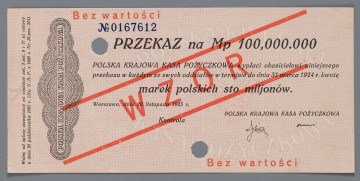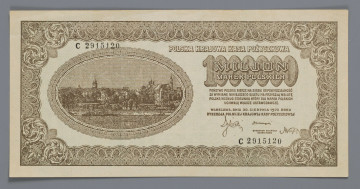
Cheque for 100,000,000 Polish marks - a template
1923
National Museum in Lublin
Part of the collection: Paper money during the Second Polish Republic
Inflation pressures and the budgetary needs of the Polish state led the Polish National Loan Fund (PKKP) to introduce six more denominations of banknotes in the second half of 1923: 250 thousand, 500 thousand, 1 million, 5 million, and 10 million Polish marks (mkp). The banknote in question, not counting transfers for 50 and 100 million Polish marks (mkp), was the highest denomination in the history of our country. In total, in the years 1919-1924 PKKP ordered the printing of at least 1,965,500,131 notes for a staggering sum of over 2 quadrillions 135 trillion mkp.
To some extent, the increase in paper currency in the years 1919-1924 was conditioned by the fact that mkp was gaining the status of the country's exclusive currency and was gradually covering the entire territory of the Republic. The printing of banknotes was mainly used to finance the budget deficit, which was a constant problem of the rebuilding state. Inflation fuelled by banknotes became an element of a vicious circle within a few years. Initially, its moderate form stimulated economic activity, contributed to a decrease in unemployment and supported the competitiveness of Polish exports. At the same time, it caused a nominal increase in budget expenditure, which, as already mentioned, was financed by money printing. A factor that influenced the hyperinflation of 1923 was the collapse of the German mark, to which the mkp was linked. During 1923 there was an increase in the price of the dollar from 17,850 to 6,400,000 mkp. High prices, low wages as well as unemployment, caused outbreaks of social discontent resulting in street riots and strikes.
The 10 million mkp banknote was designed by the State Graphic Works in Warsaw. It was printed in this printing house and in the Printing House of the Publishing Institute “Biblioteka Polska” in Bydgoszcz. On the day of its introduction to circulation (December 20), advertisements in “Kurier Warszawski” offered gramophone records of “the latest repertoire” for 500,000 each, a men's fur coat “elegant and new” for 125 million, a Ford car - model from 1924 - for 900 dollars (about 5 billion 760 million mkp). In December 1923 a loaf of bread cost 96 thousand mkp.
Tomasz Markiewicz
Author / creator
Dimensions
cały obiekt: height: 203 mm, width: 92 mm
Object type
paper money
Technique
Material
paper
Creation time / dating
Creation / finding place
Owner
The National Museum in Lublin
Identification number
Location / status

1923
National Museum in Lublin

1923
National Museum in Lublin

1923
National Museum in Lublin
DISCOVER this TOPIC
National Museum in Szczecin
DISCOVER this PATH
Educational path